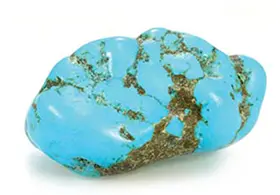
Discovering the Origins
Turquoise, an opaque mineral, exhibits various shades of blue and green due to its copper content. The name ‘turquoise’ derives from the Old French ‘turqueise’, meaning ‘Turkish’. This stone is sourced from various locations including the United States, Mexico, France, Egypt, the Middle East, Russia, Peru, China, and Tibet.
Historical Significance and Lore
Contrary to the belief that it originated from Turkey, turquoise was actually traded there, primarily coming from Iran and the Sinai Peninsula. Esteemed by ancient Egyptians, Sumerians, and Aztecs, and considered sacred by some Native American tribes, turquoise symbolizes the connection between earth and heaven.
Healing Uses
Turquoise is celebrated for its calming effects, promoting peace and well-being. It balances mood swings, reduces stress, and alleviates depression. Its purifying properties aid detoxification and protect against pollution. Aligning with the throat and heart chakras, wearing turquoise necklaces enhances communication and emotional well-being.
Magical Uses
A favored stone in healing spells, turquoise offers protection against physical, psychic, and environmental harm and attracts good fortune and abundance when used as an amulet or talisman.
Feng Shui Applications
In Feng Shui, placing turquoise in the Wealth/Prosperity sector attracts fortune, while in the Marriage/Relationships sector, it fosters harmony. In the Health/Well-Being sector, it draws healing energy and restores balance.
Personal and Spiritual Growth
Meditating with turquoise enhances spiritual connections, strengthens emotions, boosts confidence, and alleviates feelings of loneliness. It fosters a sense of unity with the universe, aiding in personal and spiritual development.
